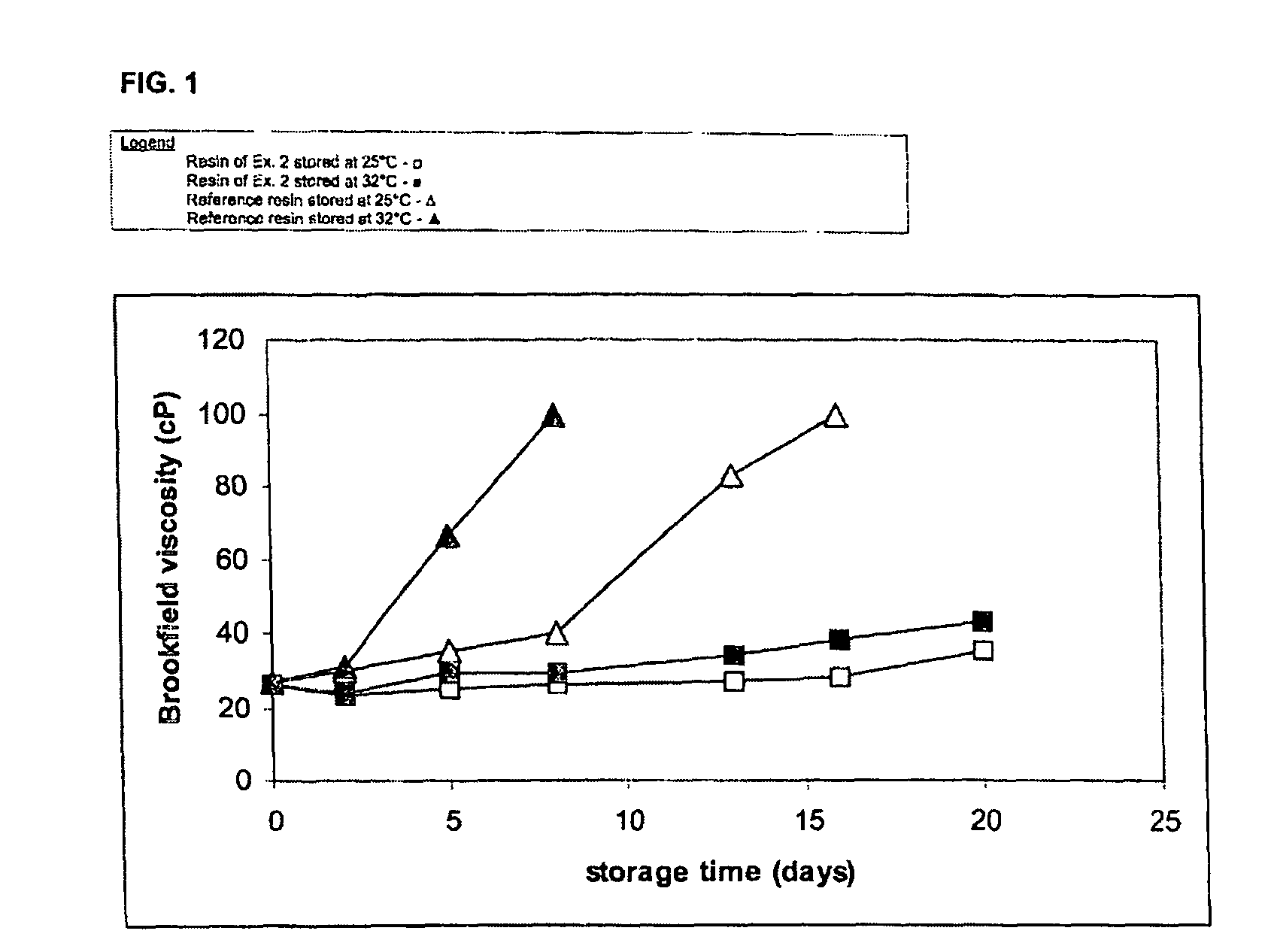Reactive cationic resins for use as dry and wet strength agents in sulfite ion-containing papermaking systems
a technology of cationic resins and sulfite ion, which is applied in the field of reactive cationic resins, can solve the problems of reducing or eliminating reducing and losing the effectiveness of glyoxalated resins
- Summary
- Abstract
- Description
- Claims
- Application Information
AI Technical Summary
Benefits of technology
Problems solved by technology
Method used
Image
Examples
example 1
[0117]a. Synthesis of dialdehyde-reactive copolymers useful in the production of reactive cationic resins.[0118]b. This example describes preparation of a dialdehyde-reactive copolymer in which a cationic comonomer, DADMAC, and a comonomer which is dialdehyde-reactive, acrylamide, are reacted together and wherein the resultant copolymer comprises 30 mole % DADMAC.[0119]c. In a jacketed one-liter glass reactor, connected to a thermostatic bath, with a five necked lid, equipped with a stirrer, temperature probe, nitrogen inlet plus cooler and two dosing points connected to four dosing pumps 68 grams of DADMAC (65% aqueous solution, Aldrich) and 316 grams of demi water were purged with nitrogen for one hour. Initiators solution of 2.6 grams of sodium metabisulfite in 52 grams of water and 0.3 grams of SPDS in 54 grams of water were prepared. Both solutions were purged for 30 minutes with nitrogen prior to dosing.[0120]d. After the nitrogen purge, the mixture was heated to 65° C. under ...
example 2
[0121]This example describes preparation of a dialdehyde-reactive copolymer in which a cationic comonomer, DADMAC, and a comonomer which is dialdehyde-reactive, acrylamide, are reacted together and wherein the resultant copolymer comprises 30 mole % DADMAC.
[0122]In a jacketed one-liter glass reactor, connected to a thermostatic bath, with a five necked lid, equipped with a stirrer, temperature probe, nitrogen inlet plus cooler and two dosing points connected to three dosing pumps 203 grams of DADMAC (65% aqueous solution, Aldrich) and 316 grams of demi water were purged with nitrogen for one hour. Initiators solution of 2.6 grams of sodium metabisulfite in 52 grams of water and 0.3 grams of SPDS in 54 grams of water were prepared. Both solutions were purged for 30 minutes with nitrogen prior to dosing.
[0123]After the nitrogen purge, the mixture was heated to 65° C. under gentle stirring. When the DADMAC / water mixture reached 65° C. the initiator feed pumps were started at a dosing r...
example 3
[0124]This example describes preparation of a dialdehyde-reactive copolymer in which a cationic comonomer, DADMAC, and a comonomer which is dialdehyde-reactive, acrylamide, are reacted together and wherein the resultant copolymer comprises 30 mole % DADMAC, and wherein the resultant copolymer contains a low level of residual monomer.
[0125]In a jacketed one-liter glass reactor, connected to a thermostatic bath, with a five necked lid, equipped with a stirrer, temperature probe, nitrogen inlet plus cooler and two dosing points connected to three dosing pumps, 136.7 grams of DADMAC (65% aqueous solution, Aldrich) and 195.8 grams of demi water were purged with nitrogen for one hour. Initiator solution of 4.92 grams of sodium metabisulfite in 46.2 grams of water and 1.32 grams of SPDS in 49.8 grams of water were prepared. Both solutions were purged for 30 minutes with nitrogen prior to dosing.
[0126]After the nitrogen purge, the mixture was heated to 75° C. under gentle stirring. When the...
PUM
| Property | Measurement | Unit |
|---|---|---|
| pH | aaaaa | aaaaa |
| polydispersity | aaaaa | aaaaa |
| polydispersity | aaaaa | aaaaa |
Abstract
Description
Claims
Application Information
 Login to View More
Login to View More - R&D
- Intellectual Property
- Life Sciences
- Materials
- Tech Scout
- Unparalleled Data Quality
- Higher Quality Content
- 60% Fewer Hallucinations
Browse by: Latest US Patents, China's latest patents, Technical Efficacy Thesaurus, Application Domain, Technology Topic, Popular Technical Reports.
© 2025 PatSnap. All rights reserved.Legal|Privacy policy|Modern Slavery Act Transparency Statement|Sitemap|About US| Contact US: help@patsnap.com

